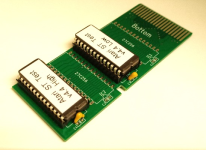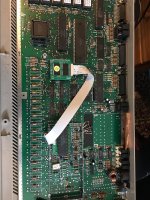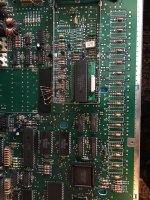There isn't actually much original commercially written software which REQUIRES 1MB of RAM, because as with all other cases of 'enhanced' machines the ones with the larger memory size suffered from lowest-common denominator syndrome, that is, it didn't make sense to write software that only a small subset of Atari ST users would be able to buy and run, therefore the vast majority of software titles, certainly games, were written to run on a 512K machine and could also run on a 1MB, 2MB, 4MB machine. A very few 512K compatible titles did offer enhanced features if they found 1MB of RAM present.
The sort of software most likely to demand more RAM falls into two categories, serious (productivity) software like some of the high-end MIDI sequencer titles, etc - and anything produced by demo / cracking crews, as they tended to want to pack as much in as possible, so demos and 'menu discs' requiring a double sided disc drive and at least 1MB or 2MB or more of memory are fairly common.
My 1986 Atari STFM came with TOS 1.0 but has for most of its life had the 'Rainbow' TOS (1.4) primarily because (HDD) (via DMA) disc operation was rather sluggish under TOS 1.0 and much quicker under TOS 1.4 - I can say this because for a time I had both versions of TOS in the machine so it was easy to flip between them and see the difference.
My STFM has TOS in 6 x ROMs and I directly replaced the original PROMs with 6 x 27256 EPROMs.
There is however one reason to favour TOS 1.0, especially if you don't plan to use an HDD or anything which pretends it is one - compatibility with a wider range of original software. A fair few titles which were written to run under TOS 1.0 found themselves broken when they tried to run on an upgraded machine - to give just one reason why, the system variables containing the mouse 'x' position and 'y' position aren't in the same RAM location in every TOS, but software writers working with TOS 1.0 (when there was no later TOS) assumed they would be. I have an original copy of the breakout clone 'Arkanoid' which came with my machine and worked with it when it had TOS 1.0 but stopped working under TOS 1.4. (Later releases of Arkanoid had this problem fixed). Software written during the later period was 'aware' of earlier TOS versions and written to work with all of them, but some software written during the early period may in some cases be hard coded to run under TOS 1.0, therefore it follows that (strangely) the most widely software-title compatible TOS is the oldest one.
You can solve this dilemma by doing what I did for a while, I programmed TOS 1.0 into the lower halves of 6 x 27512 EPROMs and TOS 1.4 into the upper halves, with the highest address pin on all 6 EPROMs bent out horizontally from the socket, all connected together and connected to a switch arranged to pull them all low (TOS 1.0) or pull them all high (TOS 1.4).
I eventually decided to run TOS 1.4 only, since there was only the one software title (that I personally owned) which would not work under TOS 1.4.





